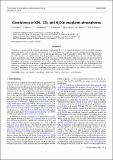Files in this item
Coexistence of CH4, CO2 and H2O in exoplanet atmospheres
Item metadata
| dc.contributor.author | Woitke, P. | |
| dc.contributor.author | Herbort, O. | |
| dc.contributor.author | Helling, Ch | |
| dc.contributor.author | Stüeken, E. | |
| dc.contributor.author | Dominik, M. | |
| dc.contributor.author | Barth, P. | |
| dc.contributor.author | Samra, D. | |
| dc.date.accessioned | 2020-11-06T17:30:02Z | |
| dc.date.available | 2020-11-06T17:30:02Z | |
| dc.date.issued | 2021-02-05 | |
| dc.identifier | 271085660 | |
| dc.identifier | 3f9be364-d2d0-4b51-bb1b-c8c6b1b057ec | |
| dc.identifier | 85100698785 | |
| dc.identifier | 000617516200001 | |
| dc.identifier.citation | Woitke , P , Herbort , O , Helling , C , Stüeken , E , Dominik , M , Barth , P & Samra , D 2021 , ' Coexistence of CH 4 , CO 2 and H 2 O in exoplanet atmospheres ' , Astronomy & Astrophysics , vol. 646 , A43 . https://doi.org/10.1051/0004-6361/202038870 | en |
| dc.identifier.issn | 0004-6361 | |
| dc.identifier.other | ArXiv: http://arxiv.org/abs/2010.12241v1 | |
| dc.identifier.other | ORCID: /0000-0002-5418-0882/work/142905081 | |
| dc.identifier.other | ORCID: /0000-0001-6861-2490/work/142905144 | |
| dc.identifier.other | ORCID: /0000-0002-3202-0343/work/142905222 | |
| dc.identifier.uri | https://hdl.handle.net/10023/20921 | |
| dc.description | P.W. and Ch.H. acknowledge funding from the European Union H2020-MSCA-ITN-2019 under Grant Agreement no. 860470 (CHAMELEON). O.H. acknowledges the PhD stipend form the University of St Andrews’ Centre for Exoplanet Science. P.B. acknowledges support from the St Leonards interdisciplinary scholarship. | en |
| dc.description.abstract | We propose a classification of exoplanet atmospheres based on their H, C, O, N element abundances below about 600 K. Chemical equilibrium models were run for all combinations of H, C, N, O abundances, and three types of solutions were found, which are robust against variations of temperature, pressure and nitrogen abundance. Type A atmospheres contain H2O, CH4, NH3 and either H2 or N2, but only traces of CO2 and O2. Type B atmospheres contain O2, H2O, CO2 and N2, but only traces of CH4, NH3 and H2. Type C atmospheres contain H2O, CO2, CH4 and N2, but only traces of NH3, H2 and O2. Other molecules are only present in ppb or ppm concentrations in chemical equilibrium, depending on temperature. Type C atmospheres are not found in the solar system, where atmospheres are generally cold enough for water to condense, but exoplanets may well host such atmospheres. Our models show that graphite (soot) clouds can occur in type C atmospheres in addition to water clouds, which can occur in all types of atmospheres. Full equilibrium condensation models show that the outgassing from warm rock can naturally provide type C atmospheres. We conclude that type C atmospheres, if they exist, would lead to false positive detections of biosignatures in exoplanets when considering the coexistence of CH4 and CO2, and suggest other, more robust non-equilibrium markers. | |
| dc.format.extent | 10 | |
| dc.format.extent | 3014646 | |
| dc.language.iso | eng | |
| dc.relation.ispartof | Astronomy & Astrophysics | en |
| dc.subject | Planets and satellites: atmospheres | en |
| dc.subject | Planets and satellites: composition | en |
| dc.subject | Astrochemistry | en |
| dc.subject | QC Physics | en |
| dc.subject | QD Chemistry | en |
| dc.subject | 3rd-DAS | en |
| dc.subject.lcc | QC | en |
| dc.subject.lcc | QD | en |
| dc.title | Coexistence of CH4, CO2 and H2O in exoplanet atmospheres | en |
| dc.type | Journal article | en |
| dc.contributor.sponsor | European Commission | en |
| dc.contributor.institution | University of St Andrews. School of Physics and Astronomy | en |
| dc.contributor.institution | University of St Andrews. St Andrews Centre for Exoplanet Science | en |
| dc.contributor.institution | University of St Andrews. School of Earth & Environmental Sciences | en |
| dc.identifier.doi | 10.1051/0004-6361/202038870 | |
| dc.description.status | Peer reviewed | en |
| dc.identifier.url | https://arxiv.org/abs/2010.12241 | en |
| dc.identifier.grantnumber | 860470 | en |
This item appears in the following Collection(s)
Items in the St Andrews Research Repository are protected by copyright, with all rights reserved, unless otherwise indicated.

